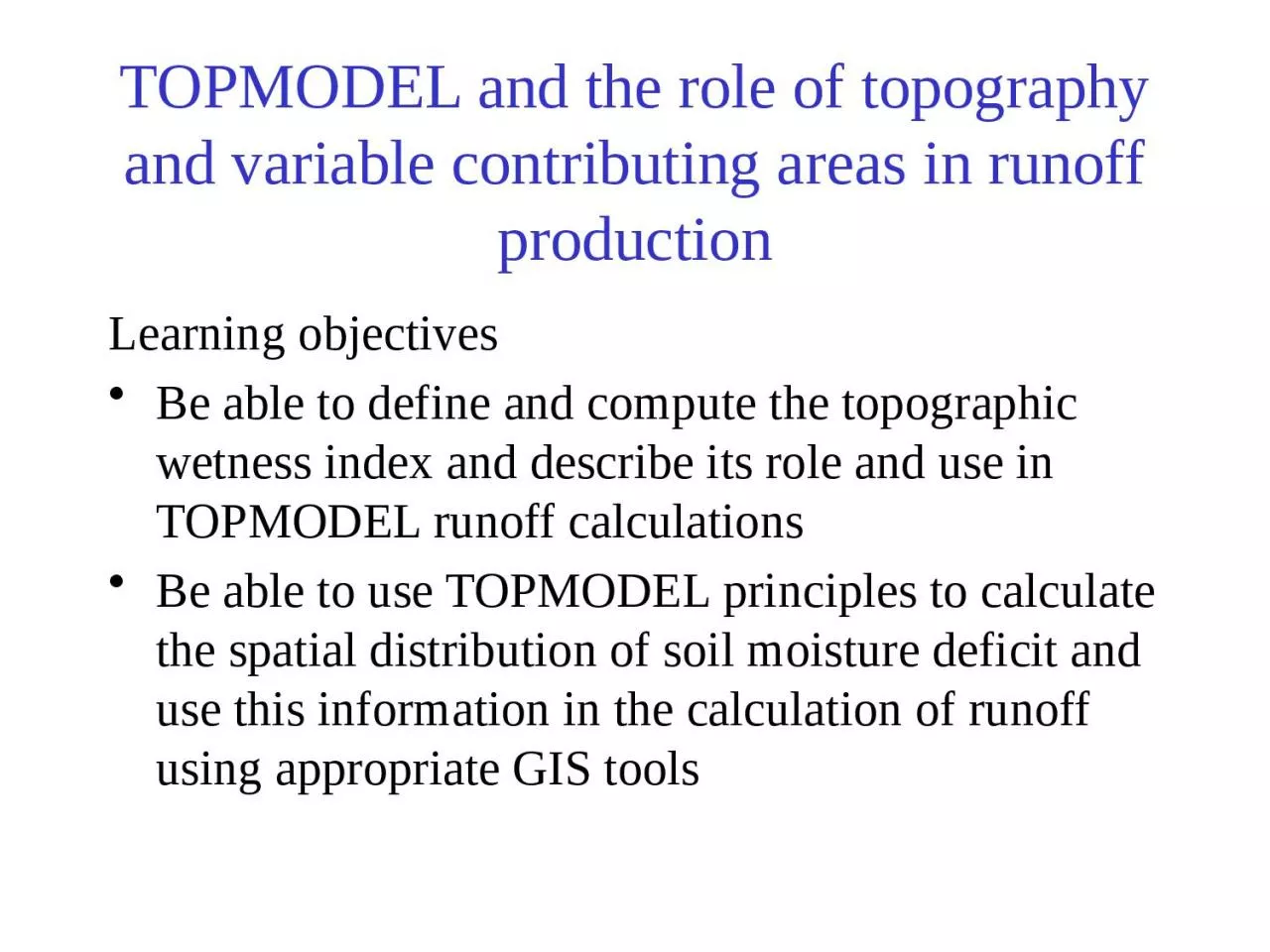

Learning objectives Be able to define and compute the topographic wetness index and describe its role and use in TOPMODEL runoff calculations Be able to use TOPMODEL principles to calculate the spatial distribution of soil moisture deficit and use this information in the calculation of runoff usin ID: 1026456
Download Presentation The PPT/PDF document "TOPMODEL and the role of topography and ..." is the property of its rightful owner. Permission is granted to download and print the materials on this web site for personal, non-commercial use only, and to display it on your personal computer provided you do not modify the materials and that you retain all copyright notices contained in the materials. By downloading content from our website, you accept the terms of this agreement.
1. TOPMODEL and the role of topography and variable contributing areas in runoff productionLearning objectivesBe able to define and compute the topographic wetness index and describe its role and use in TOPMODEL runoff calculationsBe able to use TOPMODEL principles to calculate the spatial distribution of soil moisture deficit and use this information in the calculation of runoff using appropriate GIS tools
2. TOPMODELBeven, K., R. Lamb, P. Quinn, R. Romanowicz and J. Freer, (1995), "TOPMODEL," Chapter 18 in Computer Models of Watershed Hydrology, Edited by V. P. Singh, Water Resources Publications, Highlands Ranch, Colorado, p.627-668.“TOPMODEL is not a hydrological modeling package. It is rather a set of conceptual tools that can be used to reproduce the hydrological behaviour of catchments in a distributed or semi-distributed way, in particular the dynamics of surface or subsurface contributing areas.”
3. Hydrological processes within a catchment are complex, involving:MacroporesHeterogeneityFingering flowLocal pockets of saturationHowever:The general tendency of water to flow downhill is however subject to macroscale conceptualizationHydraulic conductivity tends to decrease with depth
4. TOPMODEL Key IdeasSurface saturation and soil moisture deficits based on topographySlopeSpecific Catchment AreaTopographic ConvergencePartial contributing area conceptSaturation from below (Dunne) runoff generation mechanismMap of saturated areas showing expansion during a single rainstorm. The solid black shows the saturated area at the beginning of the rain; the lightly shaded area is saturated by the end of the storm and is the area over which the water table had risen to the ground surface. [from Dunne and Leopold, 1978]
5. Specific catchment area a is the upslope area per unit contour length [m2/m m]Upslope contributing area aStream lineContour lineTopographic Definition
6. Topmodel - AssumptionsThe soil profile at each point has a finite capacity to transport water laterally downslope.Hydraulic conductivity decreases exponentially (as a rough macroscale approximation)Hydraulic gradient approximated by topographic slopeSzwzKUnitsz m T m2/hr f m-1K m/hr S dimensionless q m2/hr = m3/hr/m
7. Topmodel - AssumptionsDrainage of saturated zone supports baseflowDynamics of saturated zone approximated by successive steady state representationsRecharge rate spatially homogeneousThe actual lateral discharge is proportional to specific catchment area.Specific catchment area a [m2/m m] (per unit contour length)SzwR is proportionality constant that may be interpreted as “steady state” recharge rate, or “steady state” per unit area contribution to baseflow.aRq
8. Soil moisture deficit at a point and depth to water table is determined by equating topographic and profile q and solving for zwSpecific catchment area a [m2/m m] (per unit coutour length)Saturation when zw<0. i.e. Topmodel – Local depth to water table Szwq
9. Specific catchment area a [m2/m m] (per unit coutour length)D=ezw m= e/f SzwqD= ezw Topmodel – Local soil moisture deficitPoints with equivalent topographic wetness index respond similarly in terms of runoff generation Define
10. Specific catchment area a [m2/m m] (per unit coutour length) SzwqD= ezw Topmodel – Spatial Averages
11. Local soil moisture deficit a function of average soil moisture deficit and topographic wetness indexAverage soil moisture deficit a function of streamflow (baseflow) and watershed drainage parametersEnables spatial modeling of runoff generation from topography and aggregate watershed propertiesSpecific catchment area a [m2/m m] (per unit coutour length)SzwqD= ezw Topmodel - Summary
12. Topographic variability for runoff generation summarized by distribution of wetness index expressed as a histogramSpecific catchment area a [m2/m m] (per unit coutour length)SzwqD= ezw Topmodel – Wetness Index Histogram saturatedIncreasing DDrainageRecharge
13. TOPMODEL and GISSurface saturation and soil moisture deficits based on topographySlopeSpecific Catchment AreaTopographic Convergence
14. Topographic Slope?Topographic Definition Drop/DistanceLimitation imposed by 8 grid directions.
15. Numerical Evaluation with the D AlgorithmUpslope contributing area aStream lineContour lineSpecific catchment area a is the upslope area per unit contour length [m2/m m]Tarboton, D. G., (1997), "A New Method for the Determination of Flow Directions and Contributing Areas in Grid Digital Elevation Models," Water Resources Research, 33(2): 309-319.) (http://www.engineering.usu.edu/cee/faculty/dtarb/dinf.pdf)
16. Contributing Area using D8Contributing Area using D
17. SlopeSpecific Catchment AreaWetness Index ln(a/S)from Map Calculator.Average, l = 6.9
18. Numerical ExampleGiven Ko=10 m/hrf=5 m-1Qb = 0.8 m3/sA (from GIS)ne = 0.2Raster calculator -( [ln(sca/S)] - 6.9)/5+0.46 Compute R=0.0002 m/h l=6.9 T=2 m2/hr
19. Calculating Runoff from 25 mm RainstormFlat area’s and z <= 0 Area fraction (81 + 1246)/15893=8.3%All rainfall ( 25 mm) is runoff0 < z rainfall/effective porosity = 0.025/0.2 = 0.125 mArea fraction 546/15893 = 3.4%Runoff is P-z*0.2 (1 / [Sat_during_rain ]) * (0.025 - (0.2 * [z]))Mean runoff 0.0113 m =11.3 mmz > 0.125 m Area fraction 14020/15893 = 88.2 %All rainfall infiltratesArea Average runoff11.3 * 0.025 + 25 * 0.083 = 2.47 mmVolume = 0.00247 * 15893 * 30 * 30 = 35410 m3